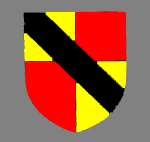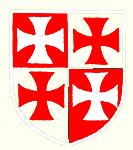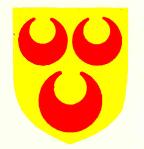The Manor of Hockliffe

Arms of the Barony of Bedford
The history of the manor of Hockliffe can be found in Volume III of The Victoria County History for Bedfordshire of 1912. In 1086 the Manor of Hockliffe was held by Azelina, the widow of Ralph Taillebois or Tallboys. Along with other lands held by Ralph Taillebois the manor subsequently became part of the Barony of Bedford. In 1265 the last Baron of Bedford, John de Beauchamp, was killed at Evesham, fighting for Simon de Montfort against King Henry III (1216-1271). Hockliffe Manor belonged to the share of the manor inherited by John de Beauchamp's sister Beatrice and the overlordship descended through her to the Nevill and Latimer families.
In a law suit of 1227 William Eversend relinquished 2½ hides in Hockliffe to John Malherbe, the first known sub-tenant of Hockliffe Manor. John had died by 1242/3 when his heir was under age and in the custody or Roger de Scaccario. This was presumably Robert Malherbe, whose nephew, another John, inherited the manor by 1251. In 1255 Richard, Earl of Cornwall, the brother of King Henry III, tried to deprive the overlord of Hockliffe, William de Beauchamp, of his rights in the manor on the grounds that Robert Malherbe had alienated all his lands to the Jews. This attempt did not succeed as in 1283 when a fatal wrestling match took place at Hockliffe the 'heir of John Malherbe' was in the wardship of William de Muntchesney.

Chetwood coat of arms
At some time between 1283 and and 1302 Hockliffe Manor passed into the hands of co-heirs. The first, Lucy Malherbe, married Sir Robert Chetwood and held the manor jointly with William Pont in 1302-3. John de Amaury held a messuage and 2 carucates of land in Hockliffe when he died in 1344, which was held from him by John de Chetwood, son of Lucy, for a rent of 9 marks per annum. John de Amaury's son Edmund was under age and this rent was granted by the king, along with wardship of Edmund himself, to John Herlyng. After Edmund de Amaury's death in 1350 the jurors at an inquisition post mortem into his estate were unable to identify an heir. In 1351 Sir John Amaury made a settlement of Hockliffe Manor, which Nicholas Chetwood, his wife Elizabeth and son Guy held for life. It appears he subsequently alienated all his rights in the manor which from then on was held only by the Chetwoods.

de Wahull coat of arms
In 1391 John Chetwood, son of Nicholas was in possession of the manor. After his death in 1412 he was succeeded first by his elder son, another John, and then in 1420 to his younger son, Thomas. Thomas Chetwood died c.1458 leaving as his heir his sister Agnes, wife of Thomas de Wahull, who held the barony of Odell. Hockliffe Manor then followed the same descent as the barony and Odell Manor until 1584. Another Agnes de Wahull married first Richard de Chetwood and then Sir George Calveley. The manor was inherited by her son Richard Chetwood, from whom it passed to the Hillersdon family in 1610/11 [PC/AC2/25]. In 1614 Thomas Hillersdon received letters patent confirming his right to hold a court leet and view of frankpledge at Hockliffe. For the next century Hockliffe descended with the Hillersdon family's other property in Elstow, until it was sold to Alan Lord Bathurst in 1712. The manor was sold again in 1719 to John Reynal. The Reynal family and their descendants retained possession into the twentieth century, with John James Reynal Adams of Hockliffe House lord of the manor in 1906.
Presumably because the manor of Hockliffe was divided into two parts at an early date the practice of holding manor courts lapsed for a considerable time until it was revived in the eighteenth and nineteenth centuries. As a result very few manorial documents survive for Hocklilffe. There appears to have been no manor house relating to this property during the post-medieval period and the manorial lands were divided into farms and leased out. Manorial courts were held at the Swan Inn, one of two inns which belonged to the manor along with the Bull. [PL/AC2/25]
The Victoria County History states that a second Hockliffe manor appeared in the fourteenth century; however, no manorial records survive for this property and the National Archives' manorial documents register for Bedfordshire does not list a second manor in the parish. It is likely that this represented the share of the manor of Hockliffe which passed to a second female co-heir of the Malherbe family. In 1314 Henry de Adingrave and his wife Ellen conveyed land at Hockliffe to John de Adingrave in 1314, and in 1342 his son Thomas de Adingrave transferred half a manor in Hockliffe to Thomas Fermbaud, his wife Alice [probably an Adingrave] and her heirs. By 1428 this property was held by Thomas Strange. The next reference comes in 1489 when it belonged to John Broughton, whose family were still in possession in 1519. In 1528 "Hockliffe Manor" was held by William Staysmore from Dunstable Priory. It then passed through various hands including those of William Sheppard and William Jervis before becoming the property of Christopher Eastwick. In 1602 Eastwick demised this estate, including land in Hockliffe, Leighton Buzzard, Battlesden, Tilsworth, Chalgrave and Stanbridge, to John Wells [CH219]; it was in turn demised to Henry Chester of Tilsworth in 1637/8 [CH225]. It seems probable that the Stonehouse was the main farm (or "demesne" farm) attached to this manor [HER 11638], but no later references either to the farm or to the manor are known.